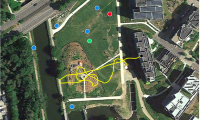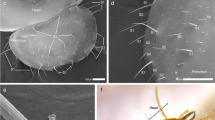Abstract
Aerial dispersal may be important for redistribution of spider mites into new habitats. Evidence for behavioral control of aerial take-off has been well documented for Tetranychus urticae Koch. Before aerial dispersal they exhibit the aerial take-off posture that involves lifting the forelegs upright and raising the forebody. However, whether the aerial take-off posture functions to increase drag has remained unclear. The objectives of this study were to clarify: (i) aerodynamic effects of the aerial take-off posture; and (ii) actual aerial take-off behavior in T. urticae. To evaluate the aerodynamic forces experienced by grounded spider mites in different postures, we constructed three-dimensional models of T. urticae, exhibiting the aerial take-off posture and the normal posture, using computer graphics. We found that the aerial take-off posture was effective in receiving greater rearward forces from wind rather than upward forces. As a result, aerial take-off from a horizontal platform is unlikely. Instead, inverted departure surfaces, e.g., lower leaf surfaces, with inclines are likely to be effective sites for take-off. Laboratory experiments and field observations indicated that the mites preferentially adopted such a position for orientation and take-off. Our findings provided a rationale for the take-off behavior of Tetranychus spider mites.










Similar content being viewed by others
References
Bell JR, Bohan DA, Shaw EM, Weyman GS (2005) Ballooning dispersal using silk: world fauna, phylogenies, genetics and models. Bull Entomol Res 95:69–114
Boykin LS, Campbell WV (1984) Wind dispersal of the twospotted spider mite (Acari: Tetranychidae) in North Carolina peanut fields. Environ Entomol 13:221–227
Brandenburg RL, Kennedy GG (1982) Intercrop relationships and spider mite dispersal in a corn peanut agro-ecosystem. Entomol Exp Appl 32:269–276
Collins RD, Margolies DC (1991) Possible ecological consequences of heterospecific mating behavior in two tetranychid mites. Exp Appl Acarol 13:97–105
Croft BA, Jung C (2001) Phytoseiid dispersal at plant to regional levels: a review with emphasis on management of Neoseiulus fallacis in diverse agroecosystems. Exp Appl Acarol 25:763–784
Das GM (1959) Bionomics of the tea red spider, Oligonychus coffeae (Nietner). Bull Entomol Res 50:265–274
De Angelis JD, Larson KC, Berry RE, Krantz GW (1982) Effects of spider mite injury on transpiration and leaf water status in peppermint. Environ Entomol 11:975–978
Duffner K, Schruft G, Guggenheim R (2001) Passive dispersal of the grape rust mite Calepitrimerus vitis Nalepa 1905 (Acari, Eriophyoidea) in vineyards. J Pest Sci 74:1–6
Fleschner CA, Badgley ME, Ricker DW, Hall JC (1956) Air drift of spider mites. J Econ Entomol 49:624–627
Grace J, Wilson J (1976) The boundary layer over a Populus leaf. J Exp Bot 27:231–241
Grafton-Cardwell EE, Granett J, Normington SM (1991) Influence of dispersal from almonds on the population dynamics and acaricide resistance frequencies of spider mites infesting neighboring cotton. Exp Appl Acarol 10:187–212
Greene DF, Johnson EA (1989) A model of wind dispersal of winged or plumed seeds. Ecology 70:339–347
Gullan PJ, Kosztarab M (1997) Adaptations in scale insects. Ann Rev Entomol 42:23–50
Hoy MA (1982) Aerial dispersal and field efficacy of a genetically improved strain of the spider mite predator Metaseiulus occidentalis. Entomol Exp Appl 32:205–212
Hussey NW, Parr WJ (1963) Dispersal of the glasshouse red spider mite Tetranychus urticae Koch (Acarina, Tetranychidae). Entomol Exp Appl 6:207–214
Janzen DH (1970) Herbivores and the number of tree species in tropical forests. Am Nat 104:501–528
Johnson DT, Croft BA (1976) Laboratory study of the dispersal behavior of Amblyseius fallacis (Acarina: Phytoseiidae). Ann Entomol Soc Am 69:1019–1023
Jung C (2001) Aerodynamic aspects of dispersal take-off behavior among the phytoseiid mites, Phytoseiulus persimilis, Neoseiulus fallacis and N. californicus. Korean J Appl Entomol 40:125–129
Jung C, Croft BA (2000) Survival and plant-prey finding by Neoseiulus fallacis (Acari: Phytoseiidae) on soil substrates after aerial dispersal. Exp Appl Acarol 24:579–596
Jung C, Croft BA (2001) Aerial dispersal of phytoseiid mites (Acari: Phytoseiidae): estimating falling speed and dispersal distance of adult females. Oikos 94:182–190
Lawson DS, Nyrop JP, Dennehy TJ (1996) Aerial dispersal of European red mites (Acari: Tetranychidae) in commercial apple orchards. Exp Appl Acarol 20:193–202
Li J, Margolies DC (1993a) Effects of mite age, mite density, and host quality on aerial dispersal behavior in the twospotted spider mite. Entomol Exp Appl 68:79–86
Li J, Margolies DC (1993b) Quantitative genetics of aerial dispersal behaviour and life-history traits in Tetranychus urticae. Heredity 70:544–552
Li J, Margolies DC (1994) Responses to direct and indirect selection on aerial dispersal behaviour in Tetranychus urticae. Heredity 72:10–22
Margolies DC (1987) Conditions eliciting aerial dispersal behavior in banks grass mite, Oligonychus pratensis (Acari: Tetranychidae). Environ Entomol 16:928–932
Margolies DC (1995) Evidence of selection on spider mite dispersal rates in relation to habitat persistence in agroecosystems. Entomol Exp Appl 76:105–108
Margolies DC, Kennedy GG (1988) Fenvalerate-induced aerial dispersal behavior of the two-spotted spider mite, Tetranychus urticae Koch. Entomol Exp Appl 46:233–240
McMurtry JA, Croft BA (1997) Life-styles of phytoseiid mites and their roles in biological control. Ann Rev Entomol 42:291–321
Mitchell R (1973) Growth and population dynamics of a spider mite (Tetranychus urticae K., Acarina: Tetranychidae). Ecology 54:1349–1355
Osakabe M (1967) Biological studies on the tea red spider mite, Tetranychus kanzawai Kishida, in tea plantation. Bull Tea Res Stn 4:1–156
Osakabe Mh, Goka K, Toda S, Shintaku T, Amano H (2005) Significance of habitat type for the genetic population structure of Panonychus citri (Acari: Tetranychidae). Exp Appl Acarol 36:25–40
Pels B, Sabelis MW (1999) Local dynamics, overexploitation and predator dispersal in an acarine predator-prey system. Oikos 86:573–583
Sabelis MW, Afman BP (1994) Synomone-induced suppression of take-off in the phytoseiid mite Phytoseiulus persimilis Athias-Henriot. Exp Appl Acarol 18:711–721
Sabelis MW, van Baalen M, Pels B, Egas M, Janssen A (2002) Evolution of exploitation and defense in tritrophic interactions. In Dieckmann U, Metz JAJ, Sabelis MW, Sigmund K (eds) Adaptive dynamics of infectious diseases: in pursuit of virulence management. Cambridge University Press, Cambridge, pp 297–321
Saito Y (1983) The concept of “life types” in Tetranychinae. An attempt to classify the spinning behavior of Tetranychinae. Acarologia 24:377–391
Saito Y, Osakabe Mh (1992) A new fixation method for preparing mite specimens for optical and SEM microscopic observations. Appl Entomol Zool 27:427–436
Sances FV, Wyman JA, Ting IP (1979) Physiological responses to spider mite infestations on strawberries. Environ Entomol 8:711–714
Smitley DR, Kennedy GG (1985) Photo-oriented aerial-dispersal behavior of Tetranychus urticae (Acari: Tetranychidae) enhances escape from the leaf surface. Ann Entomol Soc Am 78:609–614
Smitley DR, Kennedy GG (1988) Aerial dispersal of the two-spotted spider mite (Tetranychus urticae) from field corn. Exp Appl Acarol 5:33–46
Stephens GR, Aylor DE (1978) Aerial dispersal of red pine scale, Matsucoccus resinosae (Homoptera: Margarodidae). Environ Entomol 7:556–563
Tsagkarakou A, Navajas M, Lagnel J, Pasteur N (1997) Population structure in the spider mite Tetranychus urticae (Acari: Tetranychidae) from Crete based on multiple allozymes. Heredity 78:84–92
Washburn JO, Washburn L (1984) Active aerial dispersal of minute wingless arthropods: exploitation of boundary-layer velocity gradients. Science 223:1088–1089
Acknowledgements
This study was supported by the 21st Century Centers of Excellence Program of Innovative Food and Environmental Studies Pioneered by Entomomimetic Sciences at Kyoto University.
Author information
Authors and Affiliations
Corresponding author
Rights and permissions
About this article
Cite this article
Osakabe, M., Isobe, H., Kasai, A. et al. Aerodynamic advantages of upside down take-off for aerial dispersal in Tetranychus spider mites. Exp Appl Acarol 44, 165–183 (2008). https://doi.org/10.1007/s10493-008-9141-2
Received:
Accepted:
Published:
Issue Date:
DOI: https://doi.org/10.1007/s10493-008-9141-2




